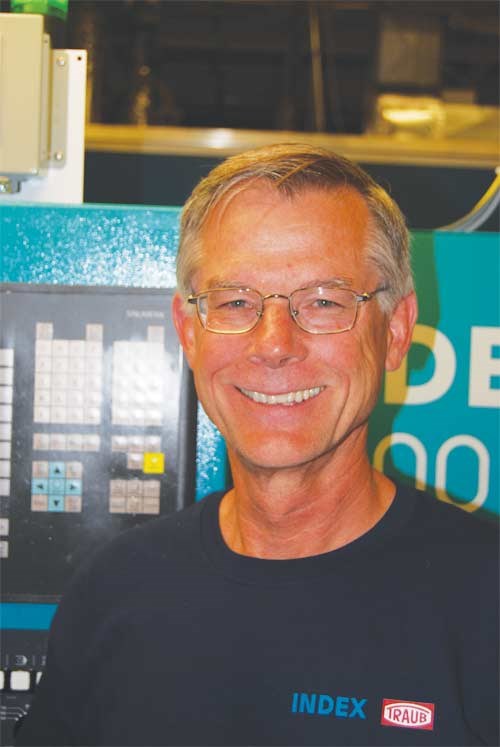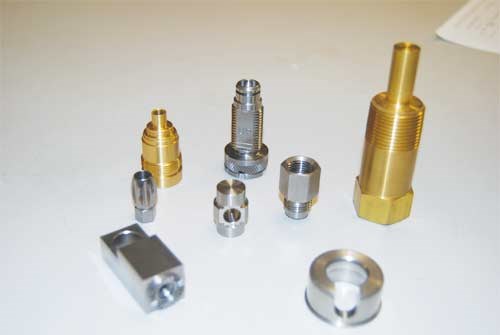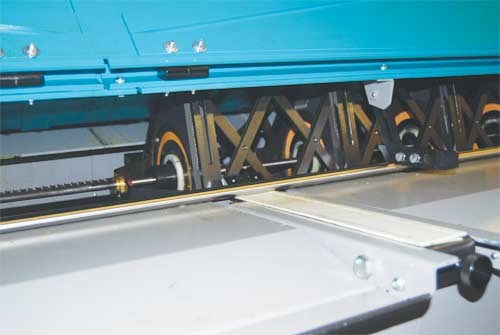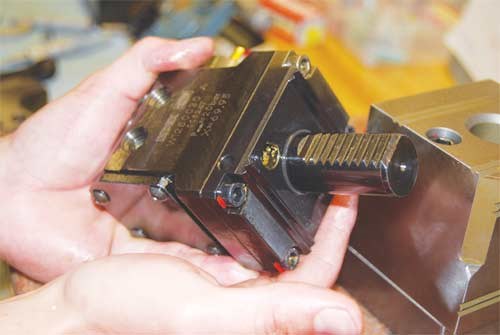Cut Cycle Times in Half
Jake Grainger says he always had a mechanical bent, and 38 years ago when he first walked into a screw machine shop he was hooked.
Jake Grainger says he always had a mechanical bent, and 38 years ago when he first walked into a screw machine shop he was hooked. Then, in 1973, he and his brother Gary borrowed some money, started their own shop, and essentially worked for no pay for 5 years to finance the company. They started Alpha Grainger in a tin garage in Natick, Mass., with two Brown & Sharpe screw machines. The company eventually moved to its current location in Franklin, Mass.
Since then, he has not looked back and has built a strong business, producing and delivering precision parts to automotive, mechanical, electronic and other customers.
“We think of ourselves as part of our customers’ manufacturing process, even if some of them do not,” Jake Grainger says. He is a very hands-on shop owner.
“I have run every machine we have here. I like the process. I like bringing in new stuff and making sure my people are able to use a new piece of machinery to its maximum capability,” he says. “I still love what I’m doing—working with great people.”
Mr. Grainger knows that speed and capability is essential in his machines, many of which he and his staff designed and built, and almost all of which he created the controls for, even to the extent of replacing or modifying factory controls and software.
“I have always seen that my machines could do things better or faster, but the manufacturers never permitted the capability to make improvements, so we started building our own controls,” Mr. Grainger says.
“Most machine builders are not end users. Some have a fair idea what we do and some do not,” Mr. Grainger says. “A case in point is a machine we bought that was intended for parts up to 40 mm. It had terrible software bugs that we had to work around.
“We put up with this for more than a year with many software glitches unaddressed. But because the machine’s configuration was unique, we were making money with them. These machines let us handle the complex work that was left after the simpler parts went offshore. They helped us make the transition from high-volume, multiple-spindle screw machine work,” Mr. Grainger continues.
Acting on Instinct
Mr. Grainger saw the Index C100 advertised in the trades. “The machine I looked at was the 14-axis C100 production turning machine for complex parts,” Mr. Grainger says. “And, what helped sell me was when I learned about the Index bar loader. Using it, I realized we would be able to run our hex jobs at full speed continuously.
“The nice thing about being the decision maker and the guy that has the money is I don’t have to ask anyone what to do or if they think some idea is OK. I don’t need to figure out ROI. If I want to act on instinct I can do that. So I bought the Index. And I was right,” Mr. Grainger says.
The C100 machine Mr. Grainger ordered has three 10-position tool turrets with two Y axes and identical motorized, liquid-cooled main and counter spindles. The machine is designed for fast, cost-competitive production of medium complexity parts turned from barstock to 42-mm diameter. Ideal for small to medium lot sizes, the machines deliver high performance within a small floor space and are targeted to handle fixed headstock work often run on Swiss-type machines.
According to Index (which also makes Swiss-type machines), 80 percent of the Swiss machines working today are actually making fixed headstock-type parts in the 1 1/4 inch range. Although Swiss-type machines are built to handle this bar size range, length-to-diameter ratio of many of these parts is a misapplication of the Swiss-type sliding headstock technology.
The C100 with 42-mm bar capacity is available with 7,000-rpm spindles and can run parts to 200 mm in length. The C100 drives are powerful: 25/29 kW (100 percent/40 percent) for the 42-mm version.
The machining flexibility of the C100 is a keynote of Index technology. As many as three tools can be at work simultaneously with both Y axes and backworking at the same time. And the counterspindle with linear-motor driven Z axis can be synchronized with the travel of turret No. 3. Counterspindle pick-up from the spindle is accomplished in 1.5 seconds.
Neat Machine But Neater Bar Feeder
That’s a lot of machining capability, but Mr. Grainger also really likes the machine’s bar feeder. “In our view, one of the most important features of the C100 machine is the bar feeder. Other bar feeders are not as good with the issue of high speed spindle capability and bar rattle. We even build our own for some of our other machines because other bar loaders are not capable of running the stock at the speeds the tooling is capable of. The machine has to slow down to accept the new bar.”
In the Index bar feeder, the bar is supported by a series of ball bearings 8 to 10 inches apart, which effectively prevents stock whipping or rattling in the feeder. The pusher is slightly smaller than the bar diameter in order to push remnants through the spindle.
In most feeders, the pusher collet is larger than the diameter of the bars. That leaves room inside the feeder for bars to whip and rattle, especially during high speed operation. Even hydrostatic bearings are not totally effective. Mr. Grainger has found that throwing oil in the bar channel sounds like a great theory, but it’s less effective with hex stock because the hex corners wipe away the oil.
“This feeder allows us to continuously run the parts to the top speed of the spindle—7,000 rpm—without slowing the spindle for the bar loader, even with hex and square stock,” Mr. Grainger says.
Smaller, But More Rigid
Reducing the size of the machine puts turrets and parts closer together, so traverse distances are shorter, which reduces cycle times. The compact design is actually more rigid than many larger machines, allowing Alpha Grainger to run tough parts on the Index (including plunge cuts with form tools) it could not dream of doing on some of its other machines.
The smaller footprint for the C100 is possible because of an unusual method of generating X and Z moves. The turret slides move in the X and Z directions on single-plane guideways. This permits rapids up to 2,400 ipm and accelerations as high as 1 G with maximum rigidity. The plate-type guideway of the turret slides also means turrets glide directly on the machine bed, for stiffness and dampening, both of which result in longer tool life and better surface finish.
Simultaneous machining with two Y axes at the main spindle or a Y axis at the main spindle and also one at the counterspindle—each with 70-mm travel—gives the option to divide machining operations for machining efficiency and flexibility. This flexibility is a key to reduced cycle times. For example, users can machine simultaneously with as many as three driven tools for complete machining in a single setup, including heavy milling and backworking.
The CNC is Key
Index machines typically use Siemens controls. Being a controls expert himself, Mr. Grainger likes the Siemens 840D. “We are totally cycle-time driven,” Mr. Grainger says. “I earn a living by renting machines to my customers. The faster I can make a part, the less time in it, the more likely I can underbid my competitors. Cycle times are critical.”
The Siemens CNC uses plain text for display and operation, and the screen shows all spindles and axes at one view. Programming with more than 70 user routines offers practical support down to the finest detail. An absolute measuring system knows axis and tool positions in every situation.
“The Siemens control captures all the job data and settings and stores it for the next time the part is to be run,” says machine operator Eric Green. “I can get all my tooling ready off-machine, preset the tools and put their dimensional information into the program, so tools are ready to work the instant I lock them into the turret without having to touch them off.”
Each position on each 14-station turret is equipped for preset driven tools. Large tooling capacity means short setup times and very fast cycle times even for small batches. Tools are more easily accessible than on a Swiss machine and can be changed quickly. They lock with only one screw, and because of the Index-designed toolholder mating surface, the tool location is extremely repeatable and rigid.
“Some may feel they don’t want to learn a new control, but with a positive attitude they will have no trouble learning the Siemens control,” Mr. Grainger says. “They will end up loving the Siemens control and may even wish other controls in the shop were more like that control.”
Programs are written by hand at Grainger. Lathe programs are never very long, so the company feels it is faster to write them manually. “Maybe five to ten lines of code per tool and you’re done,” Mr. Grainger says. “We do lathe programs in the text editor off-line. We’ve found that keying a lathe program into a CAM system actually takes longer than keying it into a text editor and downloading it into the Siemens control.”
A Speedy Spindle
Spindle acceleration/deceleration is one area of lost cycle time, especially on complex parts with frequent tool changes. Some machines can take up to 4 seconds to hit from zero to 6,000 rpm and another 4 seconds from 6,000 rpm to zero. A low mass, integral spindle motor used on C100 takes less than 1 second for acceleration and deceleration. With its relatively short acc/dec cycle, this spindle can be at a new speed faster than the tool can position, eliminating wait time and reducing cycle time.
Thermal stability is another important key. According to Mr. Green, “When we turn on the C100 in the morning there is no spindle warm-up period, and we are making good parts right away all day. On some of our other machines, thermal compensation was a big issue. On this machine, thermal growth is addressed by chilling the drive and castings, and they use glass scales. On a recent run, the machine was producing two brass parts per minute, 1,000 a day with no trouble at all and no thermal variation.”
Justifying the Purchase
How does Mr. Grainger justify the cost of an Index machine? “On one of our parts, we were getting paid for a 52-second cycle time on the other machines,” he recalls. “On this machine, we can drop the part complete in 29 seconds, in part because we don’t have to slow down the machine on hex jobs thanks to a great bar loader.
“The cost of the machine tool divided by the number of years you have it reduces the cost of the machine to very little,” Mr. Grainger says. “Running over two shifts, the cost basically goes away. The more important cost is paying the guy that runs the machine. Having a highly productive machine that runs all day solves that problem.”
Mr. Grainger continues, “It’s hard to predict ROI before you get the machine, but if you come at the machine, say machine ‘X’ is $400,000 and machine ‘Y’ is $600,000, and you divide that through the years you have it, that’s only about $2,000 a month for a better, faster machine. Then the question becomes: Can this generate more than $2,000 new revenue a month? The answer is resoundingly, ‘Yes!’ So it is not that hard of a decision to make if you come at it from that point of view.”
Keeping an eye on exchange rates doesn’t hurt either. “With the dollar recently able to buy more in Europe, European machine tools have become much more price competitive than they were even a year ago,” Mr. Grainger says.
Much of what Mr. Grainger has learned through the years still serves him well. Basically, he learned everything: From controls, to programming, to machine operation to purchasing. That knowledge applied has given his shop an edge in creating the processes and employing the technologies to profitably produce precision parts. It’s a model that has legs despite the economy.
Related Content
5-Axis Machining Centers Transform Medical Swiss Shop
Traditionally a Swiss machine shop, Swiss Precision Machining Inc. discovers a five-axis machining center that has led the company to substantial growth. (Includes video.)
Read MoreKeeping Watch on Small Parts
From watch parts to exotic medical applications, this shop takes on the world of micromachining.
Read MoreA Mill-Turn’s Value for Machining Micro Gears
This leading manufacturer of non-lubricated robotic gears uses a seven-axis turn-mill to machine components from “amorphous” metals such as bulk metallic glasses.
Read MoreDigitalization and Done-In-One Reign Supreme at BIEMH 2024
European manufacturers may have a different balance of markets than their U.S. counterparts, but the practical challenges they must overcome are often similar — as are the solutions.
Read MoreRead Next
Seeing Automated Workpiece Measurement in Real Time
User-friendly inspection software for CNC machining centers was shown at IMTS 2024 monitoring measurements between and after machining while performing SPC based on recorded measurement values.
Read More5 Aspects of PMTS I Appreciate
The three-day edition of the 2025 Precision Machining Technology Show kicks off at the start of April. I’ll be there, and here are some reasons why.
Read MoreDo You Have Single Points of Failure?
Plans need to be in place before a catastrophic event occurs.
Read More


























